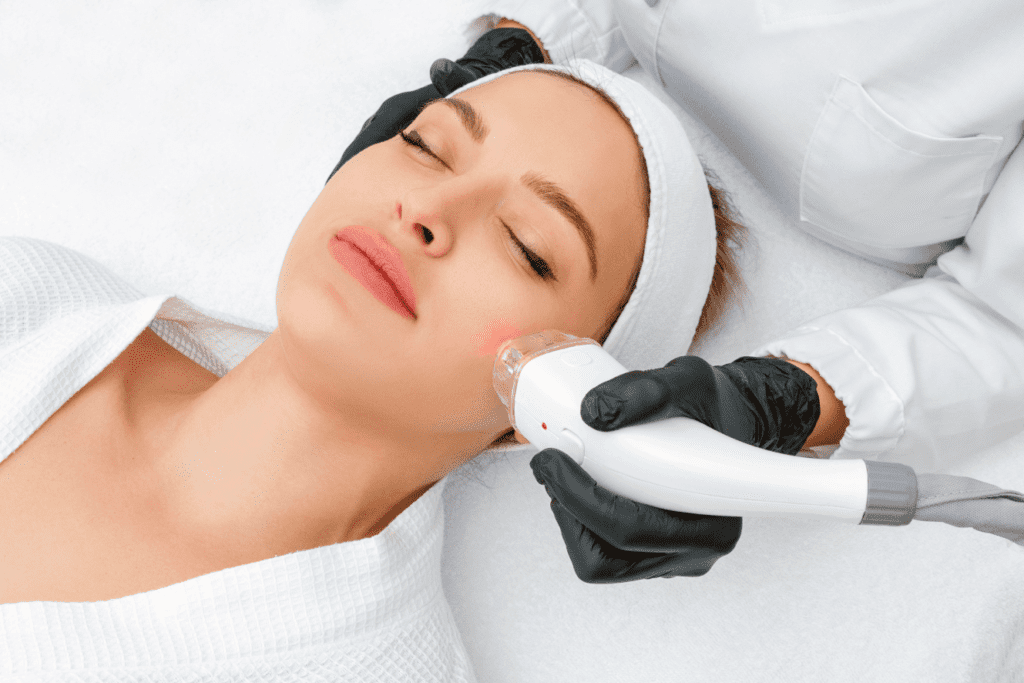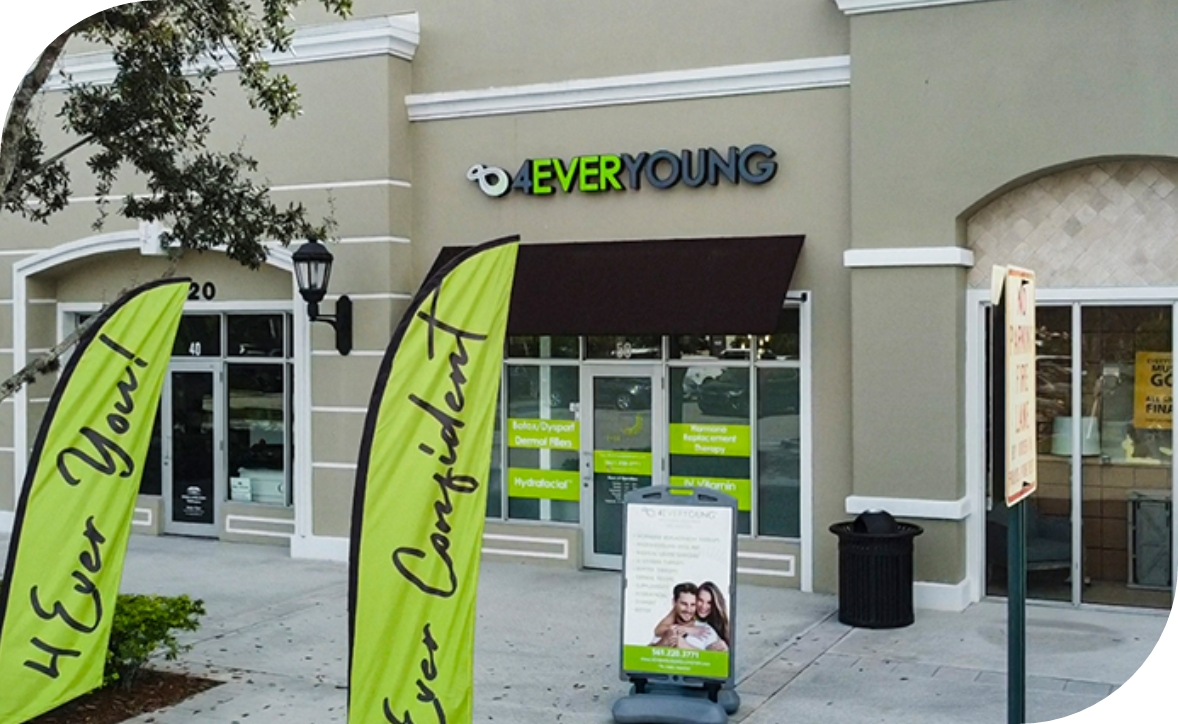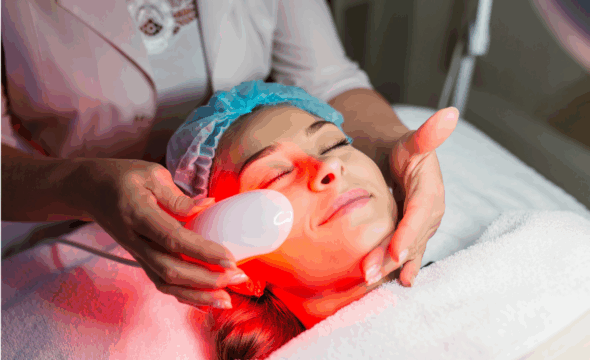IPL Photofacial Vs. Traditional Laser: Pros and Cons
In the world of skin rejuvenation, two popular light-based therapies often come up: IPL photofacial treatments and traditional laser procedures. Both aim to fix issues like sunspots, redness, and signs of aging, yet they work in different ways and offer distinct advantages. Laser skin resurfacing has become so popular that it now ranks among the top three minimally invasive cosmetic treatments in the U.S.. With such high demand, it’s important to understand how an IPL photofacial treatment compares to a laser treatment for the face before deciding which is right for you. This article will break down what each treatment involves, its pros and cons, and how they stack up in terms of results, photofacial vs. laser cost, downtime, and more.

How Do IPL Photofacials and Lasers Work?
It’s easy to confuse these two since both use light energy to improve the skin. However, the technologies are not the same. Intense Pulsed Light (IPL) is not a true laser; instead, an IPL photofacial uses a broad spectrum of light wavelengths in quick, pulsating flashes. A handpiece delivers intense pulses of filtered light to the skin. Imagine a camera flash firing against your skin. Each pulse sends multiple wavelengths of light that target pigment or blood vessels in the skin. By contrast, a laser facial uses a single, focused wavelength of light. Lasers produce a very concentrated beam that zeroes in on a specific target. This fundamental difference means IPL is generally less intense per pulse and can cover a larger area, whereas lasers deliver more intense energy to a single, precise spot.
Because IPL disperses a broad range of light, it can treat several skin issues at once. For example, during one photofacial for sun damage, the light might simultaneously fade freckles, sunspots, and broken capillaries. Lasers, on the other hand, are highly specific. Different laser machines are tuned for different purposes. As a result, laser treatments tend to be more powerful on a given issue but less broad in application. IPL therapy is gentler on the skin and typically requires more sessions than laser therapy to achieve comparable results. In contrast, laser treatment is more intense, yielding more noticeable improvements in fewer sessions. Unlike lasers, IPL devices emit multiple colors of light simultaneously, allowing an IPL to address a range of concerns in one treatment.
Treating Redness, Veins, and Rosacea
For issues of redness, light-based therapies are extremely effective. The question often arises: IPL vs. laser for redness, which works better? The answer is that both can be excellent, and sometimes they are used together. IPL photofacials have been used for a long time to treat rosacea-related redness and visible capillaries. The IPL’s light is absorbed by hemoglobin in blood vessels, causing them to heat up and collapse so they fade from view. IPL is excellent for covering a large area of diffuse redness. One advantage of IPL for redness is speed. It can target numerous vessels in one flash across a broad area of skin.
On the laser side, the pulsed dye laser (PDL) is a gold-standard tool for redness and vascular lesions. Devices like the Vbeam (a PDL) emit a specific wavelength that is very strongly absorbed by blood’s color. They can be incredibly effective for discrete blood vessels and severe redness. Historically, PDL lasers were considered slightly more aggressive than IPL, sometimes causing purplish bruising that takes a week or so to resolve. Many dermatology clinics actually use both: for example, treating some areas with PDL and others with IPL, or alternating sessions, to get the benefits of each.
Treating Wrinkles and Skin Tightening
When it comes to signs of aging like fine lines, wrinkles, and mild skin laxity, laser treatments hold a clear edge over IPL. An IPL photofacial can help make your skin tone appear more even and reduce the visibility of sunspots, resulting in a more youthful appearance. However, IPL alone is not a heavy lifter for deep wrinkles or sagging skin. Intense Pulsed Light can stimulate some collagen production, but it’s modest in comparison to lasers. Suppose your goals include smoothing out etched lines, improving acne scars, or tightening lax skin under the eyes or jaw. In that case, you will likely need a true laser skin tightening or resurfacing procedure.
Laser treatments, particularly fractional and ablative lasers, are well-known for their collagen-boosting powers. Fractional CO2 or erbium lasers create micro-columns of injury in the skin that kick-start a healing response. As new collagen forms, the skin becomes firmer and plumper. Such laser resurfacing treatments can significantly soften wrinkles and even moderately tighten the skin. There are also non-ablative lasers (like Nd: YAG or non-ablative fractionals) that heat the deeper dermis without removing the top layer, primarily to induce collagen tightening. These are often nicknamed skin tightening procedures when used on the face, since their main goal is firmer, lifted skin rather than pigment correction. Patients who undergo laser-based resurfacing or tightening often experience improvements in skin texture, a reduction in fine lines, and a subtle lift or tone enhancement in lax areas.
The more aggressive the laser, the more aftercare you’ll need. A laser for pigmentation in an anti-aging context is something you plan for. If wrinkles and skin laxity are your primary concerns, a laser (or even a combination of laser + radiofrequency) will give far more noticeable results than an IPL photofacial. Some people even refer to gentle skin tightening treatment sessions as a “laser facial” because they can refresh the skin, much like a photofacial, but with a slightly more pronounced impact on texture.

Cost of Laser Resurfacing
Cost is often a deciding factor when choosing between IPL and laser treatments. Generally speaking, IPL photofacials are less expensive than laser procedures. An IPL session for the face might cost on the order of a few hundred dollars. Lasers, especially newer fractional or ablative lasers, tend to be offered at a premium, with prices ranging from several hundred to over a thousand dollars per session. When evaluating photofacial vs. laser cost, you should factor in not just the sticker price of one treatment, but how many sessions you’ll need. A full series of 3 IPL photofacials could total, say, $1,000+, while one strong laser resurfacing might be $2,000 on its own. Photofacials typically cost around $500–$1,000 per session, whereas laser skin resurfacing can range from $2,000–$4,000 for one treatment. So even though a single IPL is cheaper, multiple sessions might narrow the gap in total cost.
It’s also worth considering what you’re getting for the cost. A laser may cost more, but if one laser session delivers the result you want, it could actually be more cost-effective than a half-dozen IPL sessions that only partially get you there. On the other hand, if your needs are mild and achievable with IPL, there’s no sense in paying a premium for laser results you don’t require. Please note that these treatments are elective and not covered by insurance, so please budget accordingly. Consultations can be very useful. An experienced provider can give you a realistic idea of how many sessions of IPL or laser you’d likely need and the package pricing. Also, remember to factor in maintenance. Many people do a touch-up IPL or laser once a year or every few years to sustain results, so long-term cost is something to keep in mind. Whether you opt for the less expensive IPL or a pricier laser, ensure a qualified professional is treating you.
Recovery Time and Side Effects
When considering skin rejuvenation treatments, understanding the recovery time and potential side effects of different procedures like IPL photofacials and various laser treatments is crucial. Here are key distinctions to help you make an informed decision about what best suits your lifestyle and desired outcomes.
- IPL Treatment Recovery: After undergoing Intense Pulsed Light (IPL) therapy, most patients appreciate the relatively simple recovery process compared to more invasive skin treatments. Immediately following a session, the skin may appear flushed, similar to the effects of mild sun exposure, and some individuals also report a gentle warmth or tightness across treated areas. These short-lived effects usually resolve within a few hours to a couple of days, depending on skin sensitivity. As pigmented lesions respond to the treatment, they can initially darken before naturally exfoliating, a sign that the body is shedding damaged skin cells. During this period, makeup can effectively camouflage any temporary discoloration, allowing individuals to continue with social and professional commitments without significant interruption. Dermatologists often advise avoiding direct sunlight, saunas, and rigorous workouts for the first 24 to 48 hours, as these can exacerbate redness or slow the skin’s natural healing response. Hydration and the application of gentle moisturizers help alleviate minor irritation, while broad-spectrum sunscreen is crucial in protecting healing skin from harmful UV exposure. These straightforward aftercare steps contribute to the appeal of IPL, particularly for people who seek visible improvements in pigmentation, redness, or texture with minimal disruption to their daily routines. In the week following treatment, patients often notice subtle but progressive changes as the skin recovers and regenerates. Small crusts or flakes may form as darkened pigment sheds, a natural phase of the skin’s renewal process. This typically resolves in five to seven days, revealing brighter, more evenly toned skin beneath. Swelling, when present, is generally mild and diminishes rapidly, leaving only a faint trace of sensitivity.
- Non-Ablative Lasers: Non-ablative laser treatments, which do not break the skin’s surface, present a recovery period comparable to IPL. Patients can expect 1-3 days of redness and slight swelling, accompanied by a subtle sandy texture as microscopic skin flakes exfoliate. This type of laser provides improvement with a manageable recovery, allowing individuals to return to their regular activities relatively quickly. It’s a good middle-ground option for those seeking more noticeable results than IPL but without the extensive recovery of ablative lasers.
- Ablative Lasers: Ablative lasers, particularly fully ablative resurfacing treatments like deep CO2 lasers, necessitate a substantial recovery period. Patients may experience 1-2 weeks of raw, peeling skin requiring diligent wound care. Even fractional ablative lasers, which treat only a portion of the skin, typically involve several days of intense redness and a visible grid pattern as the skin heals. This downtime is often offset by dramatic improvements in skin quality, which require a commitment to post-treatment care and the avoidance of sun exposure.
- IPL Side Effects: IPL treatments are generally associated with fewer risks due to their gentler nature. However, improper use, such as treating recently tanned skin or employing excessively high settings for a specific skin type, can lead to burns or temporary pigment changes. This may manifest as hyperpigmentation (darkening) or hypopigmentation (light spots), especially after sun exposure following treatment. Reputable providers consistently emphasize the importance of sunscreen and thorough aftercare to minimize these potential issues and ensure optimal results.
- Laser Risks: Lasers, especially ablative types, carry a higher risk profile due to their greater energy output. Individuals with deeper skin tones must exercise particular caution, as both IPL and lasers can cause unwanted changes in pigment. The risk of long-term pigmentation issues is elevated with aggressive laser resurfacing on darker skin, underscoring the critical need for an experienced provider skilled in treating diverse skin types.
Adhering to all pre- and post-care instructions, including sun avoidance and proper aftercare product use, is paramount for safety and efficacy. Crucially, selecting a board-certified dermatologist or experienced laser technician ensures that your treatment is tailored to your specific skin type, maximizing positive outcomes while minimizing complications.

IPL photofacials and traditional laser treatments are both excellent tools for skin rejuvenation. IPL vs. laser is about choosing the right tool for the job. If you desire a gentle refresh with minimal downtime, IPL is hard to beat. If you need a serious resurfacing or tightening, lasers are the workhorse for the job. Many people will benefit from a combination of both over the years. By understanding their differences, you can make an informed decision and work with your skincare professional to chart the best course toward clearer, more radiant skin.
Sources
- Healthline – IPL Treatment: Cost, Procedure, and More healthline.com
- Mayo Clinic – Laser Resurfacing – Risks and Safety mayoclinic.org







